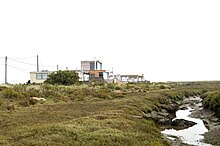Human settlement in England
| Lee-over-Sands | |
|---|---|
 Houses on Wall Street, except for the closest white house which is on Leewick Lane Houses on Wall Street, except for the closest white house which is on Leewick Lane | |
 | |
| Civil parish | |
| District | |
| Shire county | |
| Region | |
| Country | England |
| Sovereign state | United Kingdom |
| 51°46′18″N 1°03′07″E / 51.7717°N 1.052°E / 51.7717; 1.052 | |

Lee-over-Sands is a small coastal hamlet in the civil parish of St Osyth, in the Tendring district of Essex, England. It is located close to the mouth of the River Colne into the North Sea.
A sandspit called Colne Point is offshore from the hamlet. Colne Point Nature Reserve, a shingle ridge enclosing a saltmarsh, is to the west of the hamlet on the site of a World War I gravel works. Jaywick Martello Tower is 1.8 miles (2.9 km) east of Lee-over-Sands.
The area is subject to flooding, and was severely affected by the North Sea flood of 1953, when the seawall was breached in many locations near the village. Thirty-seven people died in nearby Jaywick, 3 miles (4.8 km) east of Lee-over-Sands. In January 2017 following a threat of coastal flooding, an evacuation of 2,500 homes in Lee-over-Sands and nearby Jaywick was planned, but in the event not required.
A number of houses are on the seaward side of the seawall, on Beach Road. One house on Beach Road won the RIBA East Award 2017 and the RIBA East Small Project Award 2017, and was long-listed for the national RIBA House of the Year award.
References
- ^ M.P.B. Fautley, J.H. Garon (2004). Essex Coastline: Then and Now. Potton Publishing. p. 46. ISBN 9780954801007.
- V.J. May (2003). "St Osyth Marsh, Colne Point" (PDF). Coastal Geomorphology of Great Britain. 28 (10). Retrieved 17 January 2017.
- "Colne Point Nature Reserve". Essex Wildlife Trust. Retrieved 17 January 2017.
- Charles Clover (20 January 2003). "Night when sea came two miles inland". Daily Telegraph. Retrieved 21 January 2017.
- Ross Clark (9 August 2006). "All aboard the seaside special". Daily Telegraph. Retrieved 17 January 2017.
A lot of the huts were lost in the 1953 floods," Bedford adds, "and the others went into steady decline. But they seem to be on their way up again.
- "The 1953 Flood". St Osyth Parish Council. Retrieved 21 January 2017.
The sea had broken over and through the sea wall at St Osyth Beach but the main break had been at Lee over Sands so the tidal wave was West/East toward Jaywick.
- Patricia Rennoldson Smith (2012). The 1953 Essex Flood Disaster: The People's Story. The History Press. ISBN 9780752494586. Retrieved 21 January 2017.
- "The 1953 Floods in Essex". Essex Record Office. 31 January 2013. Retrieved 21 January 2017.
- "Jaywick in Essex to be evacuated as strong winds and rain threaten to create coastal flooding". East Anglian Daily Times. 12 January 2017. Retrieved 12 January 2017.
- "Jaywick to be evacuated over flood fears". BBC News. 12 January 2017. Retrieved 12 January 2017.
- Chris Wilkin (12 January 2017). "Up to 2,500 homes in Jaywick and Lee-Over-Sands to be evacuated ahead of storm surge threat". Basildon Echo. Retrieved 13 January 2017.
- "Redshank". Architecture.com. RIBA. 2017. Retrieved 15 November 2017.
- "RIBA House of the Year". Architecture.com. RIBA. 2017. Retrieved 15 November 2017.